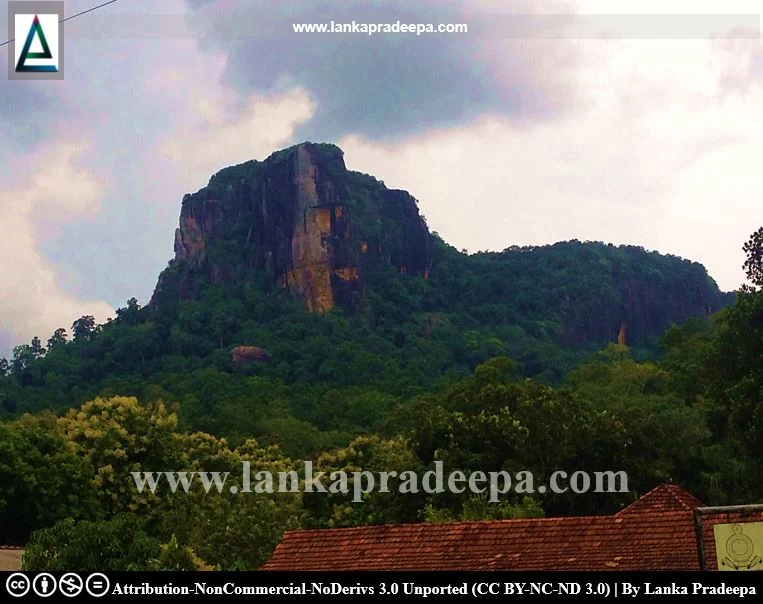
Govinda Hela, also known as Govindamala, Govindu Hela, or Westminster Abbey (Sinhala: ගෝවින්ද හෙල), is a mountain [565 m (1,853.67 ft. amsl)] with ancient ruins located in Siyambalanduwa in Monaragala District, Sri Lanka. The site can be reached by travelling through the Ampara - Siyambalanduwa highway about 43 km distance from Ampara town. The mountain is popular among local tourists as a great place for hiking and camping.
History
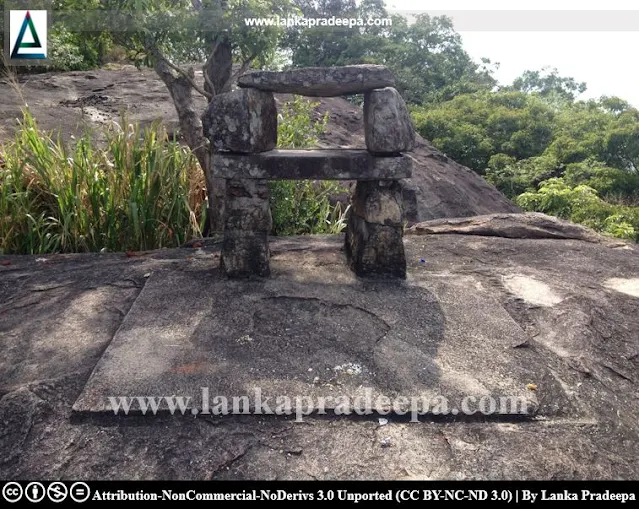 The history of Govinda Hela is going to the end of the Polonnaruwa Period. According to chronicles, the throne of the Sinhalese monarch of the country after King Nissankamalla (1187–1196 A.D.) was transitioned to the hands of several rulers who were weak in reigning or were engaged in internecine struggles (Dias et al., 2016). As a result of that, the country's political stability became poorer and the situation was comported for the invasions carried out by several Tamil invaders from South India. Magha (1215–1236 A.D.) of Kalinga (India) who came with a large army from Malabar (Kerala) invaded Sri Lanka during this period and became the ruler of the country. According to the chronicles, he was a tyrant ruler who tried to destroy the doctrine of the Buddha (Dias et al., 2016). Magha and his soldiers tortured the people and looted their properties and destroyed a large number of Buddhist temples in the country.
The history of Govinda Hela is going to the end of the Polonnaruwa Period. According to chronicles, the throne of the Sinhalese monarch of the country after King Nissankamalla (1187–1196 A.D.) was transitioned to the hands of several rulers who were weak in reigning or were engaged in internecine struggles (Dias et al., 2016). As a result of that, the country's political stability became poorer and the situation was comported for the invasions carried out by several Tamil invaders from South India. Magha (1215–1236 A.D.) of Kalinga (India) who came with a large army from Malabar (Kerala) invaded Sri Lanka during this period and became the ruler of the country. According to the chronicles, he was a tyrant ruler who tried to destroy the doctrine of the Buddha (Dias et al., 2016). Magha and his soldiers tortured the people and looted their properties and destroyed a large number of Buddhist temples in the country.While Magha was controlling the Rajarata area, some of the chieftains in the Ruhunu and Maya countries successfully prevented the invader and his hordes from entering their territories (Ray, 1960). They had built strongholds in various places in the country. Bhuwanekabahu, the prince (Adipada) of Rohana had his stronghold at Govinda hela and a military leader called Samkha had his one at Minipe (Nicholas, 1963; Ray, 1960). Another military chief named Subha had his stronghold at Subhapabbata [present Yapahuwa (Ray, 1960)]. However, these chieftains had no cooperation among them to fight with Magha (Dias et al., 2016; Ray, 1960).
Archaeological ruins
 Govinda Hela mountain is covered with a dense forest. At the north part of the mountain is the Bingoda Aranya Senasanaya, an ancient forest hermitage used by Buddhist monks since the pre-Christian era. Presently, the trail which runs to the mountain is fallen through a modern Buddhist temple, Sri Buwanekaba Viharaya.
Govinda Hela mountain is covered with a dense forest. At the north part of the mountain is the Bingoda Aranya Senasanaya, an ancient forest hermitage used by Buddhist monks since the pre-Christian era. Presently, the trail which runs to the mountain is fallen through a modern Buddhist temple, Sri Buwanekaba Viharaya.A large number of ruins of the ancient fortress still can be seen at the summit of the Govindahela mountain. Rock-cut ponds, stone pillars, base stones, flights of steps, a Sandakada Pahana (moonstone), a stone slab (probably a flower altar), a fragment of guard stone (Muragala), rock-cut pillar holes, and inscriptions are some of the ruins scattered throughout the ridge of the mountain. The inscriptions found at Govinda Hela are seemed to be written in medieval Sinhalese scripts. In one place, a square-shaped flat rock plain with horizontal rock-cut lines is identified. The horizontal lines on the plain suggest that it may have been prepared for inscribing an inscription on it but due to some reason, the author has not started his writings. Apart from these ruins, a wall made of thick rock-cut stone cubes is identified in the middle part of the mountain (Withanachchi, 2013).
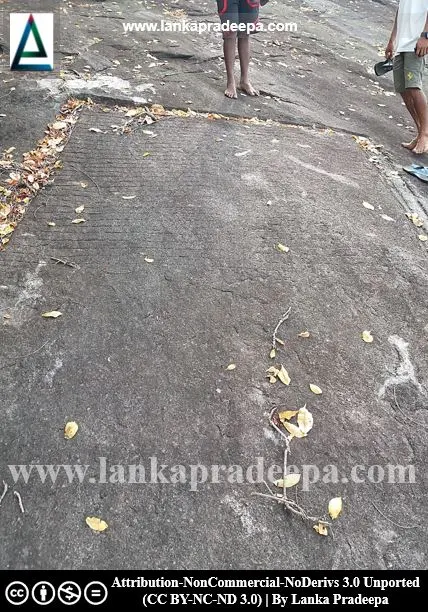





Presently, this site has become a fine place for adventurous hiking and camping. The journey usually takes about 30-45 mins to reach the top of the mountain. At the very beginning of the trail is a tree adorned with twigs from elsewhere by visitors. Mostly the people who come to visit the site hang a twig on this tree as a habit to expect no troubles during their journey and indicate to others that this is the right way to the mountain. The upper part of the mountain is very steep and ladders have been fixed at such places.
There are a number of archaeological signs and evidence on the surface of the Govinda Hela mountain. However, certain ruins at the site have already been destroyed due to the careless activities of some visitors. The below photograph (left side) shows how the rock surface near an archaeological monument has been cracked due to the ignorant deeds done by some visitors who camped at the site.
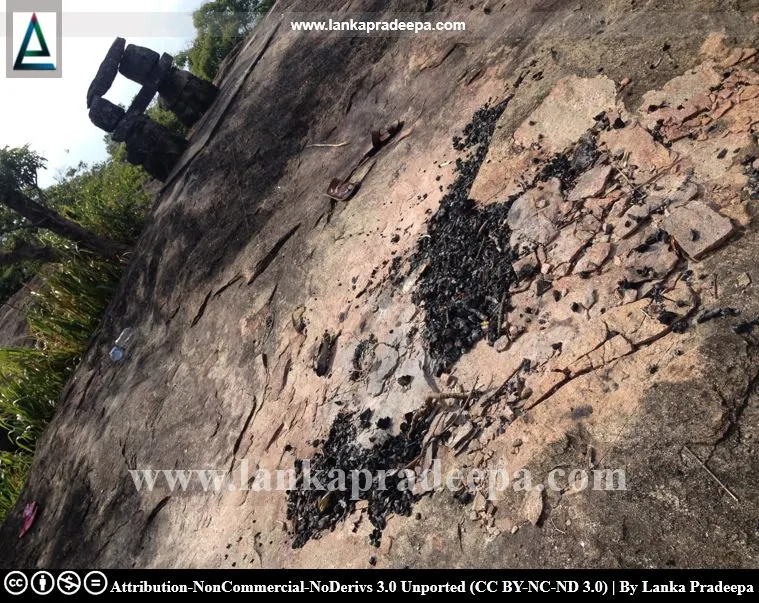


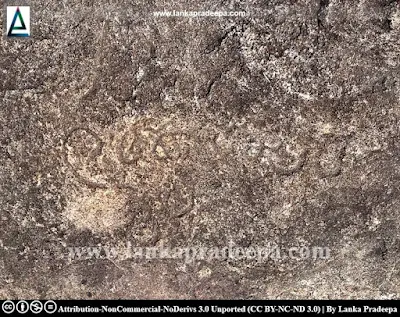
.
Do you know?
References
1) Dias, M.; Koralage, S.B.; Asanga, K., 2016. The archaeological heritage
of Jaffna peninsula. Department of Archaeology. Colombo.
pp.178-179.
2) Nicholas, C. W., 1963. Historical topography of ancient and medieval Ceylon. Journal of the Ceylon Branch of the Royal Asiatic Society, New Series (Vol VI). Special Number: Colombo. Royal Asiatic Society (Ceylon Branch). p.58.
3) Ray, H.C. (Editor in chief), 1960. History of Ceylon: Vol. I: Part II. Ceylon University Press. Colombo. p.613.
4) Withanachchi, C. R., 2013. Pauranika Sthana Saha Smaraka: Ampara Distrikkaya (In Sinhala). Department of Archaeology (Sri Lanka). ISBN: 955-9159-44-5. p. 51.
2) Nicholas, C. W., 1963. Historical topography of ancient and medieval Ceylon. Journal of the Ceylon Branch of the Royal Asiatic Society, New Series (Vol VI). Special Number: Colombo. Royal Asiatic Society (Ceylon Branch). p.58.
3) Ray, H.C. (Editor in chief), 1960. History of Ceylon: Vol. I: Part II. Ceylon University Press. Colombo. p.613.
4) Withanachchi, C. R., 2013. Pauranika Sthana Saha Smaraka: Ampara Distrikkaya (In Sinhala). Department of Archaeology (Sri Lanka). ISBN: 955-9159-44-5. p. 51.
Explore Other Nearby Attractions
Location Map (Google)
This page was last updated on 30 July 2023
A short note for local school students
ගෝවින්ද හෙළ
ගෝවින්ද හෙළ (ගොවිඳු හෙළ හෝ වෙස්ට්මිනිස්ටර් ඇබේ) ශ්රී ලංකාවේ මොණරාගල දිස්ත්රික්කයේ සියඹලාණ්ඩුව පිහිටි පුරාණ නටඹුන් සහිත පර්වතයක් වේ.
ඉතිහාසයපවත්නා පුරාවිද්යා සාධක අනූව ගෝවින්ද හෙළ ඉතිහාසය පොළොන්නරු යුගයේ අග භාගය හා සම්බන්ධ කල හැකිය. වංශකතාවන්හී දැක්වෙන ආකාරයට නිශ්ශංකමල්ල රජුගෙන් (ක්රි.ව. 1187-1196) පසු සිංහල රාජ්යත්වය දුර්වල පාලකයන් කිහිප දෙනෙකු අතට හිමිවිය. එහි ප්රතිපලයක් ලෙස රටෙහි දේශපාලන ස්ථාවරත්වය පිරිහී ගිය අතර ඉන් ඇතිවූ තත්වය දකුණු ඉන්දීය දමිළ ආක්රමණිකයන්ට වාසි සහගත විය. මේ කාලයේදී විශාල මලබාර් (කේරල) හමුදාවක් කැටුව පැමිණි කාලිංගයේ මාඝ (ක්රි.ව. 1215-1236) ශ්රී ලංකාව ආක්රමණය කොට රටෙහි පාලකයා බවට පත්විය. වංශකතා ප්රකාරව මාඝ යනු රටෙහි බුදු දර්ශනය විනාශ කිරීමට වෙරදැරූ කුරීරු පාලකයෙකි. මාඝ හා ඔහුගේ සහචරයින් මහජනයා කොල්ල කා හිංසාවට පත්කරමින් රටෙහි බෞද්ධ සිද්ධස්ථාන විශාල ප්රමාණයක් විනාශයට පත්කල බව සඳහන් වේ.
මාඝ රජරට සිට සිය පාලනය ගෙනයන විට, රුහුුණු සහ මායා රටවල්හී සිටි ප්රාදේශීය පාලකයන් කිහිපදෙනෙකු ආක්රමණිකයා හා ඔහුගේ සහචරයින් සිය ප්රදේශ තුලට ඇතුළු වීම සාර්ථකව වළක්වා ගන්නා ලදී. ඔවුන්ගේ බලකොටු රටෙහි විවිධ ස්ථානවල ඉදිකර තිබුණු අතර රෝහණයේ ආදිපාදයෙකු (කුමාරයෙකු) වූ බුවනෙකබාහු සිය බලකොටුව ගෝවින්ද හෙළ පිහිටුවා ගන්නා ලදී. මීට අමතරව සංඛ නම් සෙනෙවියා මිණිපේ ද, සුභ නම් සෙනෙවියා සුභපබ්බත ද (වත්මන් යාපහුව) සිය බලකොටු ඉදිකරන ලදී. කෙසේනමුදු, මාඝ සමග සටන් වැදීමට මෙම ප්රාදේශීය නායකයන් අතර කිසිදු සම්බන්ධයක් තිබෙන්නට ඇතැයි පැහැදිලි නැත.
පුරාවිද්යා සාධකගෝවින්ද හෙළ මීටර 500ක් පමණ උසැති ඝන කැලෑවකින් ආවරණය වූ පර්වතයකි. එහි උතුරුදිශා පාමුල පුරාණ ලෙන් විහාරයක් වූ බිංගොඩ ආරණ්ය සේනාසනය පිහිටයි. වර්තමානයේ මෙම පර්වතයට ගමන් ගන්නා මාර්ගය ශ්රී බුවනෙකබා විහාරය හරහා වැටී තිබෙයි.
ගෝවින්ද හෙළ පර්වතය මස්තකයෙහි පුරාණ බලකොටුවෙහි නටඹුන් විශාල ප්රමාණයක් දැකගත හැකිවේ. ගල් පොකුණු, ශෙෙලමය කණු, පාදම් ගල්, ගලෙහි කෙටූ පියගැට පෙළවල්, සඳකඩ පහණ, ශිලා පුවරු, මුරගල් කොටස්, කණු වලවල්, ස්තූප යැයි පැවසෙන ගොඩැලි, හා මධ්යකාලීන සිංහල අක්ෂර සහිත පර්වතයෙහි කෙටූ ශිලා ලිපි ඒ අතර වෙයි. මෙහි එක් ස්ථානයක පර්වතයෙහි පැතලි මුහුණතක කොටවන ලද චතුරස්රාකාර හරස් ඉරි සහිත සෙල්ලිපි මුහුණතකි. අර්ධ වශයෙන් කොටවන ලද හරස් ඉරි මගින් මෙය සෙල්ලිපියක් කෙටවීම පිණිස සකසන ලද්දක් යැයි උපකල්පනය කෙරෙන අතර කුමක් හෝ හේතුවක් නිසාවෙන් එහි නිර්මාපකයා විසින් අක්ෂර කෙටවීම ආරම්භ කර නැත. මීට අමතරව පර්වතයෙහි මධ්ය කොටසෙහි කපන ලද ඝන කළු ගල් කොටස් වලින් සාධන ලද බිත්තියක නටඹුන් වෙයි.විනාශයවර්තමානයේදී මෙම ස්ථානය කඳු නගින්නන් හා කඳවුරු බඳින්නන් අතර ජනප්රිය ස්ථානයකි. පර්වතය ඉහළට යාම පිණිස මිනිත්තු 30-45 අතර කාලයක් ගතවේ. පර්වතයෙහි ඉහළ කොටස දළ බෑවුමින් යුක්ත වන අතර එවැනි ස්ථානයන්හී යකඩින් කල ඉණිමග සවිකොට තිබේ. කෙසේනමුදු පර්වතය මස්තකයෙහි වූ විශාල නටඹුන් හා ස්මාරක ප්රමාණය මෙහි පැමිණි නිදන් සොරුන්ගේ හා සංචාරකයින්ගේ නොමනා ක්රියාවන් හේතුවෙන් විනාශයට පත්ව තිබෙන හා පත්වෙමින් පවතින ආකාරය දැකගත හැකිවේ.
මීට අමතරව මෙම ස්ථානය සම්බන්ධව මෙතෙක් හමුව තිබෙන ලේඛනගත හා පුරාවිද්යා ඉතිහාසය විකෘති හා සාවද්ය ලෙස අර්ථකථනය කරමින් යම් යම් පිරිස් විසින් මෙහි ඉතිහාසය හින්දූන්ගේ කාව්යයක් වන රාමායනයෙහි දැක්වෙන චරිතයක් වූ රාවණා සමග සම්බන්ධ කරනු ලබයි. කෙසේනමුදු රාමායනයෙහි සත්යතාවය මතබේදාත්මක වන බැවින් වර්තමානයේදී එය මිත්යාවක් ලෙස බැහැර කෙරේ.

